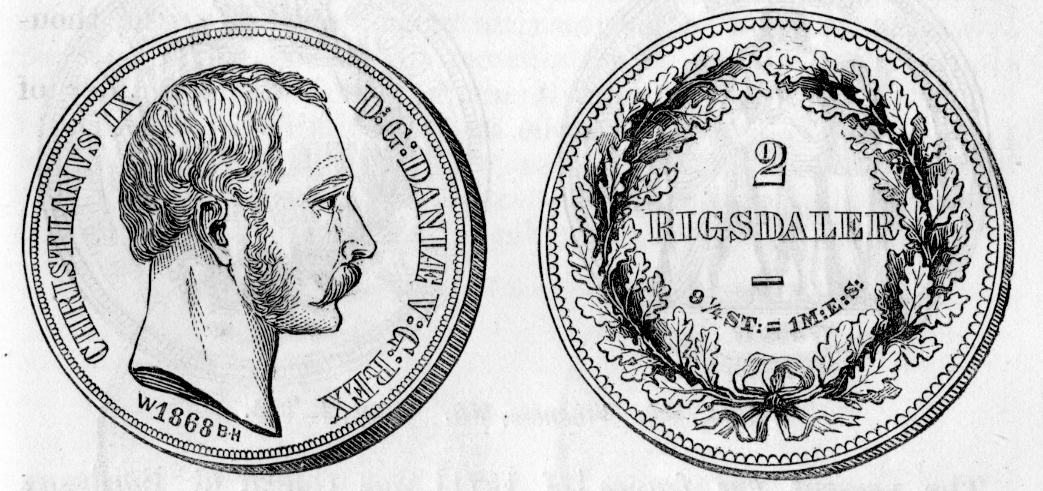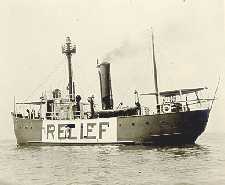|
Lightvessel Gedser Rev
Lightvessel No. XVII Gedser Rev ( Danish: Fyrskib XVII Gedser Rev) is a decommissioned lightvessel built in 1895, now serving as a museum ship in Helsingør, Denmark, having formerly been stationed in the Nyhavn Canal in Copenhagen. It is owned by the National Museum and takes its name after Gedser Rev south of Falster where it was stationed most of its working life. History Denmark's first lightvessel was built at Jacob Holm's shipyard at Christianshavn in 1829. Built at N.F. Hansen's shipyard in Odense in 1895, the Gedser Rev was number seventeen in the line of Danish lightvessels. It was first stationed at Lappegrund in shallow waters at the entrance to the Øresund. It was powered by two steam engines which were replaced by a 16- hp kerosene engine in 1918. In 1921, a new three-cylinder Voelund 135-hp propulsion engine was installed and the ship was moved to a position at Gedser Rev, south of Falster, itself the southernmost point of Denmark. In 1940, when Denmark wa ... [...More Info...] [...Related Items...] OR: [Wikipedia] [Google] [Baidu] |
Nyhavn
Nyhavn (; New Haven) is a 17th-century waterfront, canal and entertainment district in Copenhagen, Denmark. Stretching from Kongens Nytorv to the Inner Harbour just south of the Royal Playhouse, it is lined by brightly coloured 17th and early 18th century townhouses and bars, cafes and restaurants. The canal harbours many historical wooden ships. History Nyhavn was constructed by King Christian V from 1670 to 1675, dug by Danish soldiers and Swedish prisoners of war from the Dano-Swedish War 1658–1660. It is a gateway from the sea to the old inner city at Kongens Nytorv (King's Square), where ships handled cargo and fishermens' catch. It was notorious for beer, sailors, and prostitution. Danish author Hans Christian Andersen lived at Nyhavn for 18 years. The first bridge across Nyhavn opened on 1874. It was a temporary wooden footbridge. It was replaced by the current bridge in 1912. As ocean-going ships grew larger, Nyhavn was taken over by internal Danish small vessel f ... [...More Info...] [...Related Items...] OR: [Wikipedia] [Google] [Baidu] |
Horsepower
Horsepower (hp) is a unit of measurement of power, or the rate at which work is done, usually in reference to the output of engines or motors. There are many different standards and types of horsepower. Two common definitions used today are the imperial horsepower as in "hp" or "bhp" which is about , and the metric horsepower as in "cv" or "PS" which is approximately . The electric horsepower "hpE" is exactly , while the boiler horsepower is 9809.5 or 9811 watts, depending on the exact year. The term was adopted in the late 18th century by Scottish engineer James Watt to compare the output of steam engines with the power of draft horses. It was later expanded to include the output power of other power-generating machinery such as piston engines, turbines, and electric motors. The definition of the unit varied among geographical regions. Most countries now use the SI unit watt for measurement of power. With the implementation of the EU Directive 80/181/EEC on 1 January 201 ... [...More Info...] [...Related Items...] OR: [Wikipedia] [Google] [Baidu] |
List Of Lighthouses And Lightvessels In Denmark
This is a list of lighthouses and lightvessels in Denmark. Except for the island of Bornholm, Denmark is located at the transition between North Sea and Baltic Sea which includes the Skagerrak and Kattegat waters. Lighthouses See also * List of lighthouses in the Faroe Islands * Lists of lighthouses and lightvessels References External links Leuchtturm net's collection of photographs of Danish lighthouses and lightvessels * {{DEFAULTSORT:Lighthouses and lightvessels in Denmark Architecture in Denmark Denmark transport-related lists Lighthouses in Denmark, * Lists of buildings and structures in Denmark Lists of lighthouses, Denmark Ships of Denmark, *Lightships ... [...More Info...] [...Related Items...] OR: [Wikipedia] [Google] [Baidu] |
Danish Krone
The krone (; plural: ''kroner''; sign: kr.; code: DKK) is the official currency of Denmark, Greenland, and the Faroe Islands, introduced on 1 January 1875. Both the ISO code "DKK" and currency sign "kr." are in common use; the former precedes the value, the latter in some contexts follows it. The currency is sometimes referred to as the Danish crown in English, since ''krone'' literally means crown. Krone coins have been minted in Denmark since the 17th century. One krone is subdivided into 100 ''øre'' (; singular and plural), the name ''øre'' is probably derived from the Latin word for gold. Altogether there are ten denominations of the krone, with the smallest being the 50 øre coin (one half of a krone). Formerly there were more øre coins, but those were discontinued due to inflation. The krone is pegged to the euro via the ERM II, the European Union's exchange rate mechanism. Adoption of the euro is favoured by some of the major political parties; however, a 20 ... [...More Info...] [...Related Items...] OR: [Wikipedia] [Google] [Baidu] |
Danmarks Nationalbank
Danmarks Nationalbank (in Danish often simply ''Nationalbanken'') is the central bank of the Danish Realm, Kingdom of Denmark. It is a non-eurozone member of the European System of Central Banks (ESCB). Since its establishment in 1818, the objective of the Nationalbank as an independent and credible institution is to issue the Danish currency, the Danish krone, krone, and ensure its stability. The Board of Governors holds full responsibility for the monetary policy. Danmarks Nationalbank undertakes all functions related to the management of the Danish central-government debt. The division of responsibility is set out in an agreement between the Ministry of Finance of Denmark and Danmarks Nationalbank. History The bank was established on 1 August 1818 by King Frederick VI of Denmark. The private bank was given a 90-year monopoly on currency issue, which was extended in 1907 out to 1938. In 1914, the National Bank became the sole banker for the Danish government. The bank became ... [...More Info...] [...Related Items...] OR: [Wikipedia] [Google] [Baidu] |
Holmen, Copenhagen
() is a water-bound neighbourhood in Copenhagen, Denmark, occupying the former grounds of the Holmen Naval Base, Royal Naval Base and Dockyards. In spite of its name, deceptively in Grammatical number, singular, Holmen is a congregation of small islands, forming a north-eastern extension of Christianshavn between Zealand and the northern tip of Amager. Holmen was created by a series of land reclamations to house the Holmen Naval Base after it was moved from Gammelholm and used to occupy the entire area, but activities have gradually been moved elsewhere. Since the early 1990s, the area has instead been redeveloped for other use as a new district of the city, while the remaining naval facilities are confined to the northernmost islet of Nyholm. The area is today characterized by a mixture of residential developments, creative class, creative businesses and educational institutions and remaining military activities. Holmen is also home to the Copenhagen Opera House which was compl ... [...More Info...] [...Related Items...] OR: [Wikipedia] [Google] [Baidu] |
Lightvessel XVII Gedser Rev
A lightvessel, or lightship, is a ship that acts as a lighthouse. It is used in waters that are too deep or otherwise unsuitable for lighthouse construction. Although some records exist of fire beacons being placed on ships in Roman times, the first modern lightship was located off the Nore sandbank at the mouth of the River Thames in London, England, by its inventor Robert Hamblin in 1734. Lightships have since been rendered obsolete by advancing lighthouse construction techniques, and by large automated navigation buoys. Construction The most important element of lightship design is a tall mast upon which to mount the light. Initially, these lights consisted of oil lamps that were run up the mast and could be lowered for servicing, while later vessels carried fixed lamps which were serviced in place. As they became available, Fresnel lenses were used, and many vessels housed them in smaller versions of lighthouse lanterns. Some lightships had two masts, with the second ho ... [...More Info...] [...Related Items...] OR: [Wikipedia] [Google] [Baidu] |





